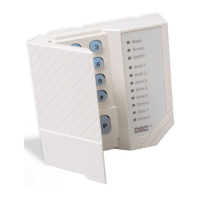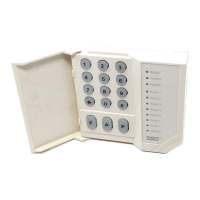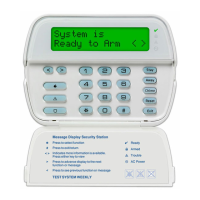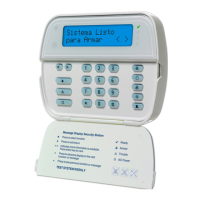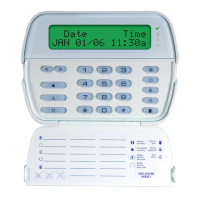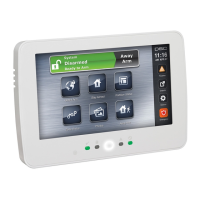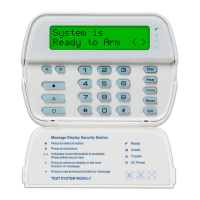7
[P] Panic
Holding this key down for two seconds causes a steady tone on your siren or
bell if your installer has programmed this key for audible operation. An auxiliary
warning device is also activated if your installer has connected it to your system.
Enter a valid access code to silence the alarm.
Fire Alarm Operations
Alarm
On a fire alarm, the bell/siren will sound pulsing. The digital communicator
transmission is delayed for 30 seconds. If the alarm is not acknowledged within
the 30 second delay, the communicator will transmit to the monitoring station.
Silence
To silence the bell/siren, press the [#] key. If the alarm is silenced and the smoke
detector is not reset, the alarm will resound after 90 seconds.
Reset
To restore the smoke detector(s) to normal, press [
∗
][7]. If the detector still has
smoke in it, the alarm will resound and the sequence described above will
repeat. If the detector is clear of smoke, the system will return to normal.
NOTE: If you suspect that the communicator has transmitted and there is no fire
condition, call the monitoring station to avoid an unnecessary response.
If a fire
condition is apparent, follow your evacuation plan immediately. If the
alarm sounds at night, evacuate immediately.
Testing Your System
It is recommended that you test your system weekly.
NOTE: Perform system tests in the off-peak hours, such as early morning or late
evening.
1. Inform the monitoring station that you are testing your system.
2. Disarm the system (“Ready” light ON).
3. Perform a bell/battery test by pressing [
∗
][6][Master Code][8]. The signal
will sound for about 2 seconds. If a trouble occurs after the test, press [
∗
][2]
to view the trouble condition.
4. Activate each sensor in turn (e.g. open a door/window or walk in motion
detector areas). Observe the zone light come ON when the zone is activated.
The zone light will go OFF when the system restores to normal (i.e. door or
window closed).
5. If they are programmed for operation, press the [F], [A], and [P] keys in turn.
The [F] key will sound the bell/siren in a pulsed mode. Enter the access code
to silence the alarm. The [A] key is silent. The [P] key may be programmed
as silent or audible. If the alarm sounds, enter the access code to silence.
6. If the panel has a zone programmed for fire, activation will cause the alarm
signal to sound in a pulsed mode.
CAUTION: Do not use an open flame or burn materials to test a smoke detector.
Contact your alarm installer for information on safe methods to activate a
smoke detector.
7. Should the system fail to operate properly, call your alarm dealer for service.
8. When testing is complete, call and advise the monitoring station.
10
Maintenance
With normal use, the system requires minimum maintenance. The following
points should be observed.
1. Do not wash the keypad with a wet cloth. Light dusting with a barely damp
cloth should remove normal accumulations of dust.
2. The battery/bell test is designed to determine battery condition, however it
is recommended that the standby battery be replaced every three years.
3. For other system devices such as passive infrared, ultrasonic or microwave
motion detectors, glassbreak detectors or smoke detectors, consult the
respective manufacturer’s literature for testing and maintenance.
Fire Safety In The Home
Most fires occur in the home and to minimize this danger it is recommended that
a household fire safety audit be conducted and a family escape plan be
developed.
Household Fire Safety Audit
1. Are all electrical appliances and outlets in a safe condition? Check for frayed
cords, over-loaded lighting circuits, etc. If you are uncertain about the
condition of your electrical appliances or household service, have a
professional evaluation.
2. Are all flammable liquids stored safely in closed containers in a well
ventilated cool area? Cleaning with flammable liquids should be avoided.
3. Are fire hazardous materials (matches) well out of reach of children?
4. Are furnaces and wood burning appliances properly installed, clean and in
good working order? Have a professional evaluation.
Family Escape Planning
There is often very little time between the detection of a fire and the time it
becomes deadly. It is thus very important that a family escape plan be
developed and rehearsed.
1. Every family member should participate in developing the escape plan.
2. Study the possible escape routes from each location within the house and
since many fires occur at night, special attention should be given to the
escape routes from sleeping quarters.
3. It is essential that escape from a bedroom be possible without opening the
interior door. Consider the following when making your escape plans:
• Make sure that doors and windows that open to the outside are easily
opened. Ensure that they are are not painted shut, and that their locking
mechanisms operate smoothly.
• If opening the exit or using the exit is too difficult for children, the elderly or
handicapped, plans for rescue should be developed. This includes
making sure that those who are to perform the rescue can promptly hear
the fire warning signal.
• If the exit is above the ground level, an approved fire ladder or rope
should be provided as well as training in its use.
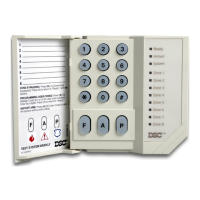
